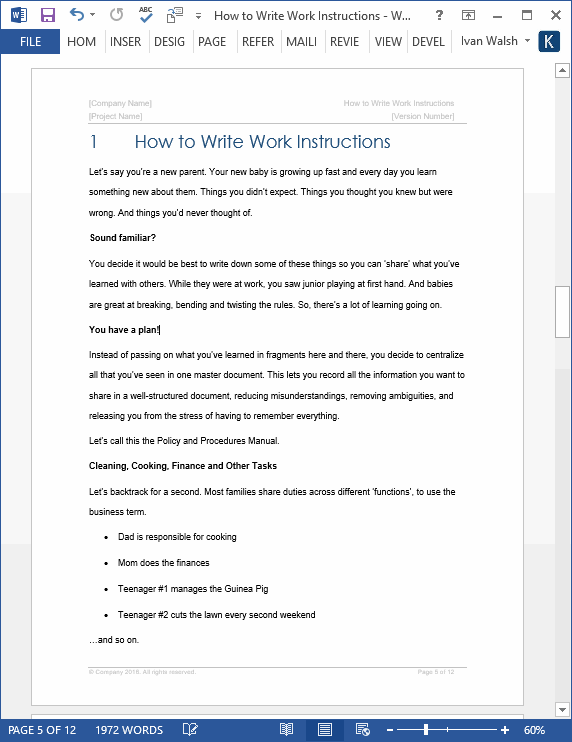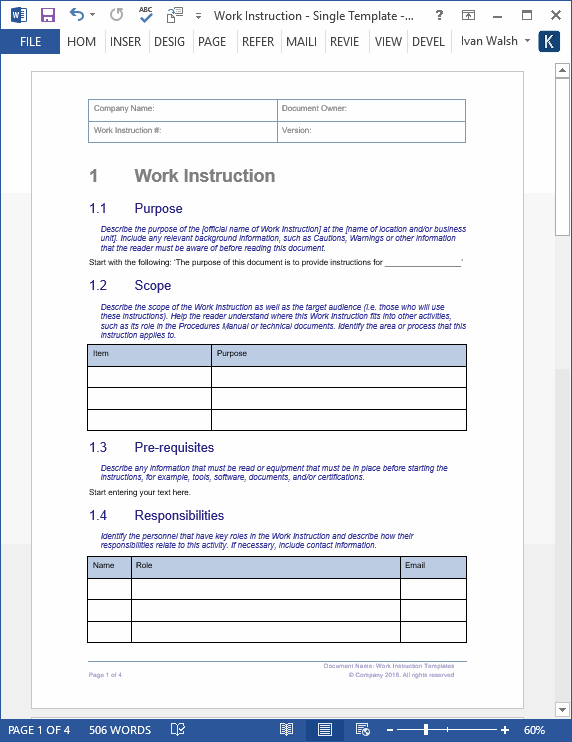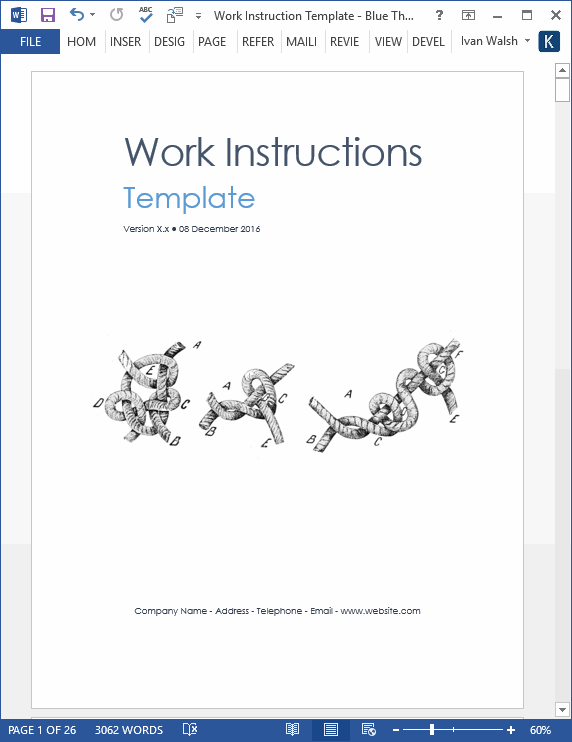Software Development Templates
How to Write Work Instructions
Summary: A Work Instruction is a step by step guide to perform a single instruction. Follow these guidelines to write Work Instructions for IT, Pharma, Biotechnology, or Construction
Download Work Instruction Templates for only 7.99!
Learn more about this template
How to Write Work Instructions
Let’s say you’re a new parent. Your new baby is growing up fast and every day you learn something new about them. Things you didn’t expect. Things you thought you knew but were wrong. And things you’d never thought of.

Learn more about this template
Sound familiar?
You decide it would be best to write down some of these things so you can ‘share’ what you’ve learned with others. While they were at work, you saw junior playing at first hand. And babies are great at breaking, bending and twisting the rules. So, there’s a lot of learning going on.
You have a plan!
Instead of passing on what you’ve learned in fragments here and there, you decide to centralize all that you’ve seen in one master document. This lets you record all the information you want to share in a well-structured document, reducing misunderstandings, removing ambiguities, and releasing you from the stress of having to remember everything.
Let’s call this the Policy and Procedures Manual.
Cleaning, Cooking, Finance and Other Tasks
Let’s backtrack for a second. Most families share duties across different ‘functions’, to use the business term.
- Dad is responsible for cooking
- Mom does the finances
- Teenager #1 manages the Guinea Pig
- Teenager #2 cuts the lawn every second weekend
…and so on.
We all do these things differently. The way I clean the room may be different than how you do it. And the way you wash the dishes may be different than my approach. Some folks pre-wash dishes before they load them into the dishwasher. Others see this as defeating the purpose or a sign of madness. Each to their own!
What has this to do with writing Work Instructions?
The way you run your house is like running a small business. People lead and people follow. Everyone’s got a role. Chores need to be done. Rules and guidelines are established. If we use the example of a household, there are three types of controls. By controls I mean any policy, procedure, guidelines, rule or whatever that must be followed. For example:
- Core controls – for example, you cannot take drugs inside the house. This is an absolute rule and applies to all members of the family.
- System controls – this is how we organize the Waste Disposal, e.g. organizing organic, non-organic, bottles, paper etc.
- Work Instructions – these are the steps we follow to ensure that the Tetra packs go to the correct bin and that organic matter doesn’t get mixed with the bottles.
Think of a pyramid.
At the top are the high-level policy/procedures, these are broken down into different manuals (cooking, finance, cleaning), and at the bottom are the actual instructions for performing each task.
1.1 How to Write Your First Work Instruction
A Work Instruction is a step by step guide to perform a single instruction.
You should be able to take the instruction and perform the task WITHOUT reading any other documents. Think of it as a standalone document. You can cross-reference, of course, but in the real world people are often looking at printouts. They may not access to computers. What they have in their hand is all they have to rely on.
So, it better be correct, right?

Learn more about this template
1.2 Key Sections in Each Work Instruction
Each Work Instruction has the following sections. Some of these may not be required depending on what you’re documenting; for example, for expediency sake, you may collapse or remove some sections.
1.2.1 Purpose
In the opening paragraph, describe what the Work Instruction does in a single sentence.
Start with: ‘The purpose of this document is to provide instructions for __________’
Most Work Instructions focus on a single area. Focus on this. Use short words and use active verbs.
Write:
‘John opened the box’
not
‘The box was opened by John’.
It easier to read and faster to type!
Next:
- Describe the purpose of the Work Instruction.
- Give its formal document name
- State where it will be used, for example, the plant, assembly line, server, or business unit.
- Include relevant background information that places the Work Instructions in content. For example, .to perform this instruction, you need to read this document first.’
- Insert Cautions, Warnings or other information that the reader must be aware of before reading this document. You can also highlight these later in the document.
1.2.2 Scope
- Describe the scope of the Work Instruction. For example, technical Work Instructions may refer to a specific Operating System, network or Database (e.g. Oracle v SAP). Highlight this to the readers and point to other technical documentation.
- Identify the target audience (i.e. those who will use these instructions), for example, System Administrators, Operators, Cashiers, Safety personnel. This helps the reader know that they’re reading the correct document and that the subject matter applies to their role.
- Help the reader understand where this Work Instruction fits into other activities, such as its role in the Procedures Manual or technical documents.
1.2.3 Pre-requisites
Describe any information that must be read, equipment that must be in place before starting the instructions, for example, tools, software, documents, and/or certifications.
You should also highlight to the reader any safety equipment that must wear before starting this procedure.
1.2.4 Responsibilities
- Identify the personnel involved in the Work Instruction and describe how their responsibilities relate to this activity.
- If necessary, include contact information, such as Name, Role and Email. Keep this brief or point the reader to the Procedures Manual.
1.2.5 Criteria
Where appropriate, identify any technical or workmanship standards that are required to perform these instructions.
1.2.6 Instructions
Provide the steps required to perform the Work Instruction.
- Use short words, active verbs and avoid ambiguity.
- List the steps to be taken in the correct sequence.
- Use flowcharts, bullet instructions, text, images, numbered instructions or any combination, providing the instructions are easily understood and accurate.
- Use a Naming Convention for the Work Instructions so you can track them in your Document Management System, for example, WI-Dept-Date-F. Dept refers to the business unit; Date is the date when it was last updated, and F refers to Final document. Use D for Draft documents.
- List the steps in numeric order.
- Use an If-Then table to describe steps where the user is presented with different options.
If I do this, Then I follow this step, Else do this.
If I do this, Then I follow this step, Else do this.
1.2.7 Revision History
Describe previous changes made to this document. Include the Revision, Description of Change and the Effective Date
1.2.8 References
List the name and reference numbers of any documents referenced in this Work Instruction. You must also reference procedures that control the Work Instruction including its control number. You may also include resources that may be useful when performing this procedure, such as for industry standards and links to other Procedure Manuals. Include the:
- Doc #
- Author
- Document Title
1.2.9 Tools, Software or Fixtures
If appropriate, list any tools required to perform the tasks described in this document
1.2.10 Safety Requirements
List all safety precautions that users must comply with and all safety equipment that must be used while following the operations specified in this work instruction.
1.2.11 Definitions
Identify and define frequently used terms and phrases that may be unique to the Work Instruction and/or business sector.
Work Instruction Template: MS Word
Learn more about this template
This Work Instruction Template Pack includes 3 Microsoft Word templates that you can easily customize to suit your requirements. You can use these templates to save time when creating policies, procedures, and checklists and also ensure that your Department has a standardized approach to documenting Work Instructions.
- Work Instruction Guide (23 pages) This templates includes sections on how to write the Purpose, Scope, Pre-requisites, Responsibilities, Criteria, Instructions, Revision History, References, Safety Requirements, and Definitions.
- Work Instruction – Single Template (4 pages) This template is used to document a single Work Instruction.
- How to Write Work Instructions Tutorial (11 pages) shows you how to write Work Instructions and how to test the document to ensure that all the steps are correct.
Download Work Instruction Templates for only 7.99!



